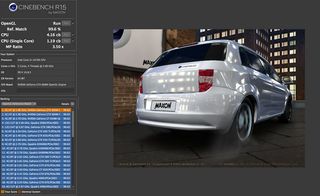
Hewlett Packard’s first ever gaming laptop is certainly a gorgeous looking beast, with plenty of attention to detail in its textured black lid, restrained use of silver accents and glowing red vents. The keyboard and speakers glow too, and the colours of these can be altered using the Control application, highlighting the WASD keys so necessary for gaming.
There’s also a great deal of power crammed into its slim and light body, with a quad-core Intel Core i7 backed by 8GB of RAM and an Nvidia GeForce 860M that has 4GB of its own memory and outputs to a superb 15.6in IPS 1080p touch-sensitive panel.
To begin, we looked at file transfer speeds to the 256GB SSD at the heart of the laptop. For this we used an external SSD connected over USB3. Five gigabytes of video files copied onto the Omen in a little under 15 seconds, at a blistering transfer rate in excess of 350MB/s. With four USB3 ports to play with, the Omen is well equipped to throw data about.
Hopes were therefore high that it would produce some good graphical benchmark results once the gaming began, and the Omen didn’t disappoint.

CPU benchmarking allowed the i7 to really let rip, scoring 642 in the Cinebench R15 CPU rendering test. The quad-core CPU is stronger in these tests than the dual-core models often found in gaming laptops, giving the Omen an advantage in the CPU-intensive games that can take advantage of those extra cores.
In Cinebench’s Open GL rendering test - which allows the GPU to shoulder some of the burden - the Omen managed nearly 90fps, putting it ahead of some Quadro professional rendering cards.
This isn’t a laptop for static rendering, however, it’s made for gaming so some games are required. One of the toughest tests you can put a laptop through is the Metro: Last Light benchmark with the settings up high. You can’t expect playable framerates in this test, as it’s designed to make the system squeal, and the Omen delivered an average framerate of 17fps with a peak of 35fps which certainly kicked the laptop’s cooling system into a higher gear.
The fans aren’t too loud, however, with the design of the cooling system and the metal case helping to dissipate heat, and they switch back to low speed soon after the load is removed. And unlike some gaming laptops, the Omen can be comfortably used on your lap without feeling too hot.

Using HP’s Omen Control application to set the fans at maximum, the noise from the heat blowers can be assessed without the distraction of a game. While they will overpower a bubbling aquarium pump or humming fridge, they don’t come on loud enough to be heard if you’re gaming with headphones on. Using the laptop’s Beats Audio speakers, the fans can be heard in the background but not enough to prove distracting if you’re trying to concentrate on a tricky tactical problem.
The BioShock Infinite benchmark is another favourite, and although it doesn’t put quite as much stress on a system as Metro: Last Light it more accurately represents the way games are actually played. HP’s black aluminium baby produced an average of 41.8fps, with peak framerates climbing into the 150s - there’s no doubting that GTX 860M’s frame-pushing ability or the rich colours of the touchscreen.
Middle-earth: Shadow of Mordor is a newer title that should effectively put the Omen’s Nvidia GPU through its paces. As the game can consume a great deal of VRAM, the 4GB available to the GeForce chip in the Omen should allow it to rip through frames full of orcs with ease. On ultra quality settings it managed a solid 30fps average with peaks all the way up to 90fps. The cooling system once again kicked into life as the game progressed, impressing with its ability to bring temperatures down once the strain was released.

Finally, another demanding benchmark: Heaven from Unigine, that renders a floating island complete with rustic houses, an airship and a detailed dragon statue. At maximum settings the Omen pumped out 18.5fps, a creditable score that puts it ahead of many other gaming laptops that sport lesser GPUs. We also ran Heaven’s sister test, Valley, which renders a more rural scene. Here, the Omen delivered 19.8fps despite the DirectX 11 ultra quality settings and 8x anti-aliasing.
These benchmark tests are of course synthetic, but attempt to recreate the demands modern games put on a laptop. HP’s Omen gaming laptop stepped up to the mark and delivered everything asked of it, proving that a lot of power resides within that slim black casing and that the smooth framerates gamers crave are easily within reach.
PC Gamer Newsletter
Sign up to get the best content of the week, and great gaming deals, as picked by the editors.
